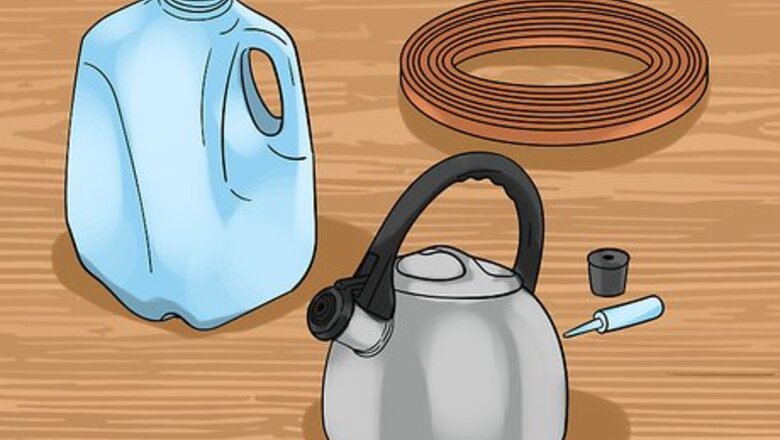
views
X
Research source
You can purchase a water still at many hardware stores, or you can build your own out of common materials.
Making a Stove-top Water Still
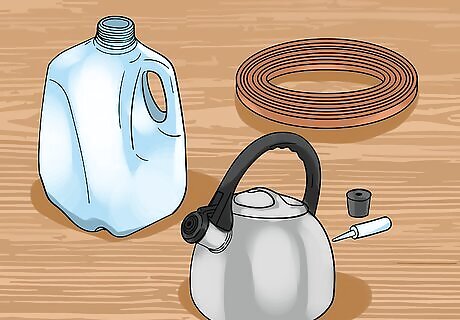
Assemble your materials. Some of these materials will likely already be in your home. Other materials might need to be purchased at a hardware store or a home-brewing supply company. Do not try to buy cheap alternatives to these products: if you want your distilled water to be safe, you will have to use food-safe, heat-resistant materials. Your supplies should include: 20ft (6 m) of 3/4-inch copper coil 6 feet of heat-proof silicone tubing A two-gallon bucket Tea kettle or pressure cooker Ice Sealer A large water bottle to collect the distilled water
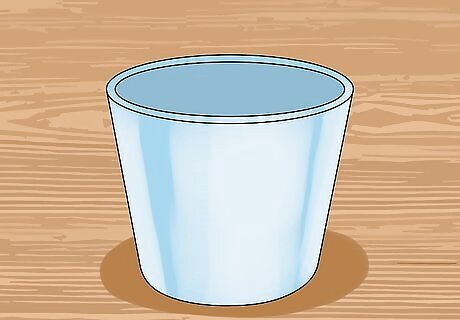
Make ice. Fill your ice cube trays or some water bottles with water and then place them in your freezer. You will want to have a lot of ice on hand during the distillation process. Keep in mind that distilling water involves boiling the water into steam and then quickly cooling it down into purified water droplets. If you plan to distill a lot of water, you will require many, many trays worth of ice.
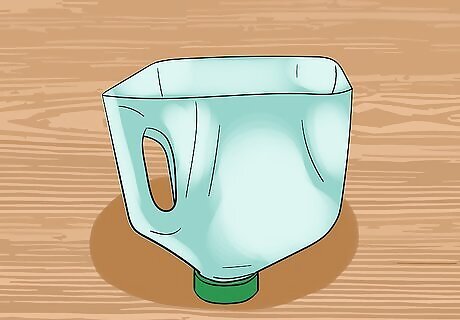
Assemble a cooling tank. Your water still will require a cool environment where the steam can re-condense into pure water droplets. The heated water will travel through waterproof, heat-proof copper tubing that is coiled inside your cooling tank, allowing the steam to cool into purified water inside the tubes. Your cooling tank can be very simple: a two-gallon plastic bucket will do. Alternatively, you could use a large milk jug that has been cut in half and filled with ice. If you are using a two-gallon bucket, be sure that there is a 3/4-inch hole at the top of the bucket and the bottom of the bucket. The copper tubing will need to be fed through both holes in order to collect the steam (at the top) and emit the water (at the bottom).
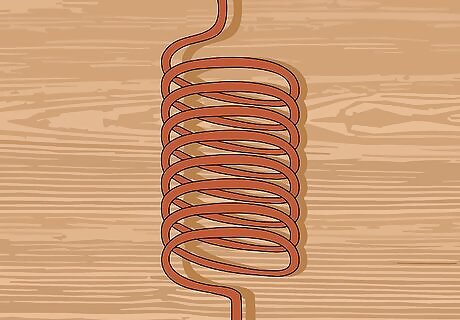
Create a condensing coil. Your water still will involve collecting the water from your heat source (the tea kettle or pressure cooker), sending it through coiled tubing inside the cooling tank to let the water condense, and then finally into your storage container for the distilled water. The most efficient way to cool the water will be to have it travel through a coiled tube that is immersed in ice water or that surrounds a very cold object (like a frozen milk jug). Coil the copper tubing about 7 or 8 times. You will have a spiral once coiled. Simply place your coiled copper tubing inside the bucket or jug, leaving a 1-inch gap in between the tubing and the sides of the bucket. Remember to feed the top and bottom of the copper coil through the holes you've drilled in the bucket. If the tube seems too loose, you can use epoxy or sealant to ensure that the tubing fits snugly in the holes.Make a Water Still Step 4Bullet1.jpg
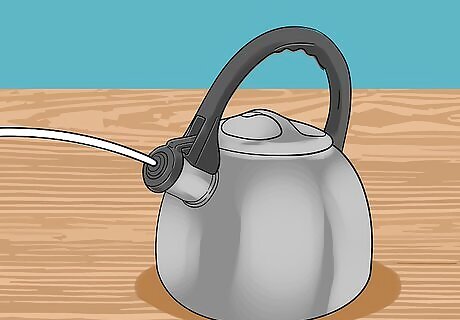
Connect 3 feet of silicone tubing to your heat source. Heatproof silicone tubing can be used to connect the source of your heated water (either your pressure cooker or tea kettle) to the top of your condenser coil. Cut the 6-ft. tubing in half to leave you with two 3-ft. tubes. If you are using a tea kettle, simply affix one end of the tubing to the spout of the kettle. If you are using a pressure cooker, affix one end of the tubing to the open pressure valve on the lid of the pressure cooker. If the pressure valve on the pressure cooker is too small, you can use a brass fitting of the same diameter as the tube to allow the silicone tubing to fit tightly.Make a Water Still Step 5Bullet1.jpg If the spout on your tea kettle is too large, simply drill a hole in a rubber stopper that is the same diameter as your tubing. Place this stopper in the kettle spout and insert your tubing.Make a Water Still Step 5Bullet2.jpg
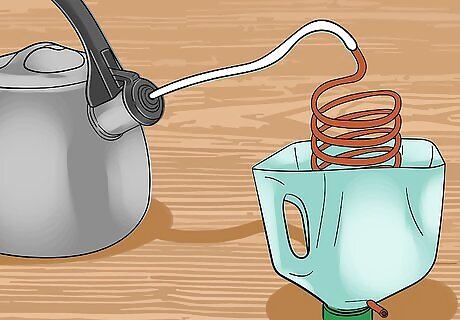
Attach the other end of your silicone tubing to the top of the condenser coil. At this point, you can connect the water source to your condenser tubing with the silicone tubing. Take the other end of the tube that you've connected to your water heater, and fit it over the copper tubing at the top of your condenser coil. Be sure you have a tight fit.
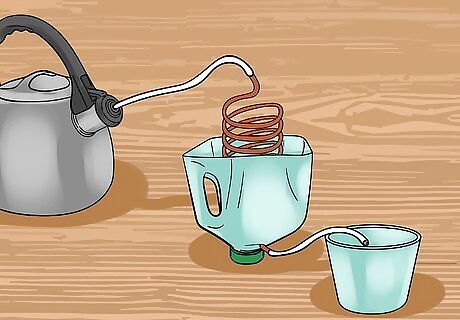
Create a spout for your condenser coil. At this point, you should have a hot water source that is well connected to a condenser coil that is affixed to a cooling system. However, you will still need a way to collect the purified water that forms inside your condensing coils. Use the other 3-ft. piece of silicone tubing to create a spout. The bottom of your condensing coil should at this point be sticking out of the bottom of your cooling tank. Attach silicone tubing to this outlet, and then place the other end over a clean water bottle. This will complete your water distillation system.
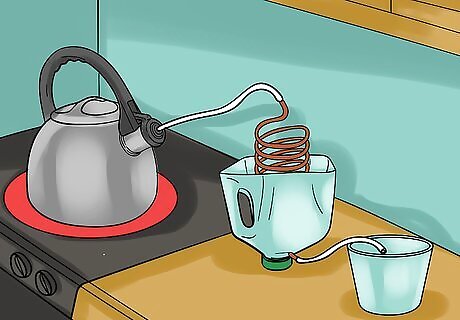
Boil your water to distill it. Fill your kettle or pressure cooker with water and place it on your stove. Turn the stove up high and wait for the water to boil. The steam will travel through your silicone tubing, into the copper tubing, and through the cooling system. There, the steam will turn into water droplets through the process of condensation, and finally travel out through your water spout and into your purified water container. All impurities such as salt, minerals, or dirt will be left behind, leaving you with pure, clean water in the final collecting bottle.
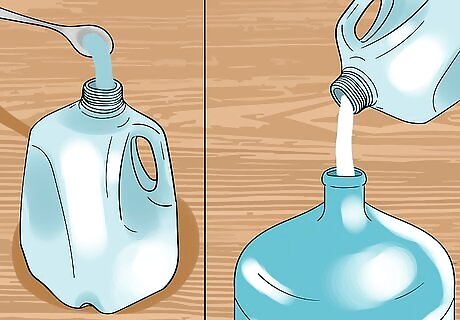
Sanitize water containers for long-term storage. If you plan to store your distilled water for long periods of time, be sure that your storage container has been thoroughly sanitized. Dilute one teaspoon of bleach in one gallon of water. Use this solution to thoroughly coat the inside of your storage container. After about 30 seconds, pour out the bleach solution. Let your container air-dry or rinse it with clean water.
Making a Solar Water Still
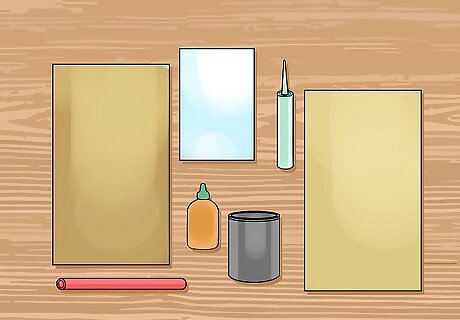
Assemble your materials. Most of the materials you require for a solar water still can be acquired at a hardware store or home-brewing supply store. A solar water still will require more handiwork and assembly than a stove-top water still, but a solar water still can come in handy in emergency situations where you do not have working electricity or gas. Your materials should include: Plywood (4 feet by 8 feet) One sheet of high-finish, tempered glass (27.25 x 22 inches) Wood glue High-temperature black paint Screws Drill with drill bits Caulk PEX tubing (2 feet) Rigid insulation Two long, flat glass baking pans
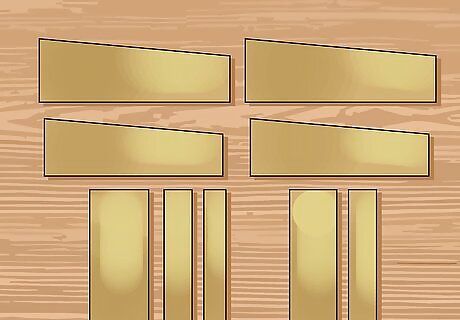
Cut the plywood into several pieces to form a wooden box. The base of your solar water still will be a wooden box made out of plywood. The top of the box should have a slight incline so that the glass top will be at an optimal angle. Your box will be made of five different plywood pieces: A bottom base that measures 23.25 x 19 inches A short end piece that measures 5.75 x 20.5 inches A long end piece that measures 9 x 20.5 inches Two trapezoidal side pieces that measure 9 1/8 inches tall (at the long end), 5 1/8 inches tall (at the short end), and 26.75 inches wide Note that a circular saw set to a 9 degree angle can help you cut the trapezoidal pieces correctly
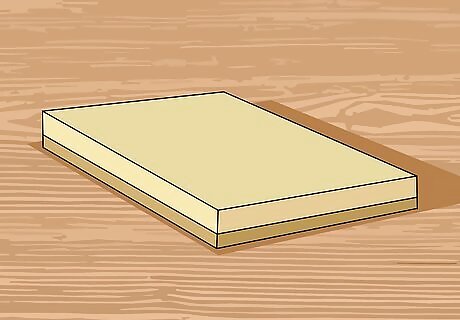
Assemble the rigid insulation. Cut a piece of rigid insulation using the same measurements as the bottom base of your plywood box. Screw the insulation to the plywood base.
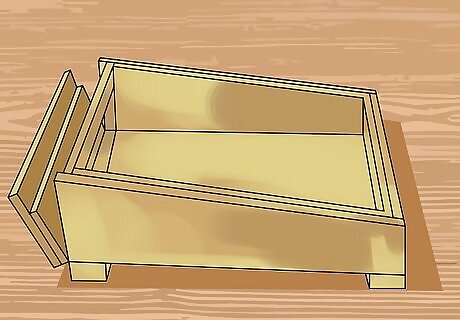
Assemble the wooden box. Using screws and wood glue, assemble all of the pieces of the wooden box together, except for the long end piece. The long end piece will be your hinged door and must be attached using separate door hinges. Make sure that the door faces the short end and that the two trapezoidal pieces face each other. Use caulk or weather seal to make sure all of the edges are airtight.
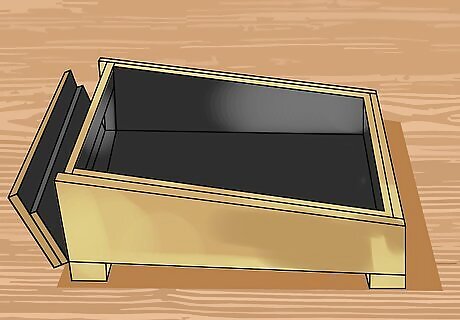
Paint the inside of the box black. High-temperature black paint will help the water inside the still heat up in the sun, allowing it to evaporate more efficiently. Coat the inside of the box thoroughly. Allow the painted box to dry for 3-5 days to ensure that all fumes and toxins are aired out before you finish assembling the still.
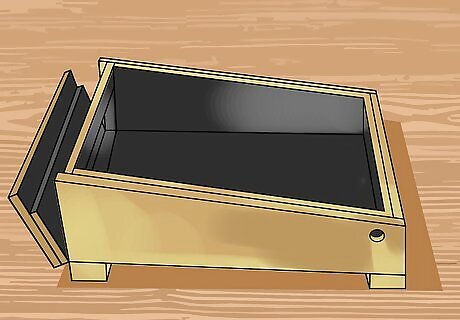
Drill a hole for the water tube. Your PEX tubing will be used to collect the water droplets that form inside the solar still and pour them into a separate, clean container. To insert the piping into the box, drill a hole the same diameter of your tubing 1/2 inch down from the top of the box at the short side of the trapezoid. Only make a hole in one of the trapezoidal pieces: not both.
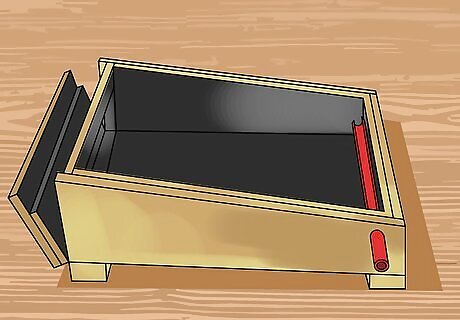
Assemble the water tube. In order to collect water effectively, your water tube must be open inside of the box (to collect water drippings) but closed outside of the box (to keep the water clean). Mark 19 inches on your PEX tubing, and slice it in half. This should leave you with a piece of tubing that is open for 19 inches and closed for 5 inches. Screw the open piping inside the short side of the box using three screws, making sure that a few inches of the closed tubing are able to stick out through the pre-drilled hole. Slope it down to a point 1/4-inch below the starting height to make sure the water flows out of the box properly. Use caulk or sealant to make sure that the piping fits snugly in the hole you drilled and that the open tubing is securely fastened to the plywood.Make a Water Still Step 16Bullet1.jpg
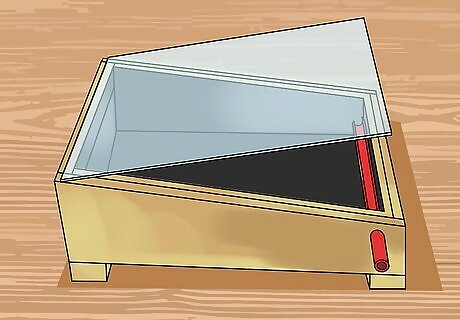
Add the glass roof. The glass plate will fit at a slight incline into the top of your water still, allowing water droplets to form inside and then flow down the incline and into your PEX water tubing. From there, the purified droplets will leave the still through the closed piping and into a separate container. After making sure your glass plate has been thoroughly cleaned, caulk the outer edges of the glass thoroughly. Then gently lay it on top of your assembled box. If you have measured correctly, the glass roof should be at a 5-10 degree angle, which is ideal for water collection. You can use a temporary stop or painters tape to secure the caulked glass roof until it has dried thoroughly.

Place glass pans filled with water inside the still. One of the sides of your still has been attached with hinges, which will allow you to open and close the door at will. Fill two flat, glass baking pans with water (1-2 inches or so), and insert them into your assembled still. This will serve as the water source that will be purified by the sun.
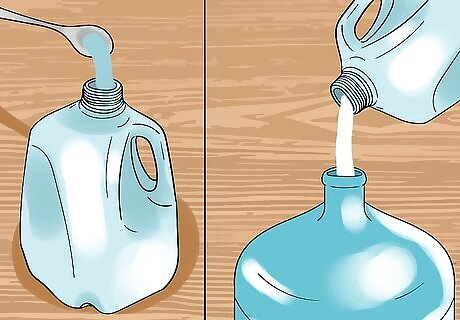
Sanitize water containers for long-term storage. If you plan to store your distilled water for long periods of time, be sure that your storage container has been thoroughly sanitized. Dilute one teaspoon of bleach in one gallon of water. Use this solution to thoroughly coat the inside of your storage container. After about 30 seconds, pour out the bleach solution. Let your container air-dry or rinse it with clean water.



















Comments
0 comment